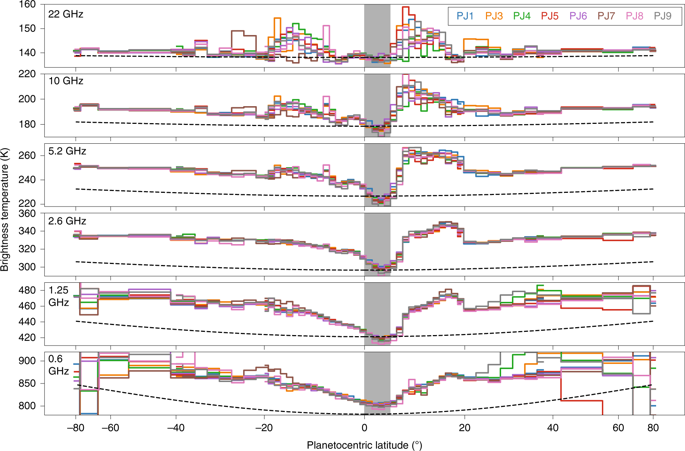Nature Astronomy ( IF 12.9 ) Pub Date : 2020-02-10 , DOI: 10.1038/s41550-020-1009-3 Cheng Li , Andrew Ingersoll , Scott Bolton , Steven Levin , Michael Janssen , Sushil Atreya , Jonathan Lunine , Paul Steffes , Shannon Brown , Tristan Guillot , Michael Allison , John Arballo , Amadeo Bellotti , Virgil Adumitroaie , Samuel Gulkis , Amoree Hodges , Liming Li , Sidharth Misra , Glenn Orton , Fabiano Oyafuso , Daniel Santos-Costa , Hunter Waite , Zhimeng Zhang

|
Oxygen is the most common element after hydrogen and helium in Jupiter’s atmosphere, and may have been the primary condensable (as water ice) in the protoplanetary disk. Prior to the Juno mission, in situ measurements of Jupiter’s water abundance were obtained from the Galileo probe, which dropped into a meteorologically anomalous site. The findings of the Galileo probe were inconclusive because the concentration of water was still increasing when the probe ceased sending data. Here we report on the water abundance in the equatorial region (0 to 4 degrees north latitude), based on data taken at 1.25 to 22 GHz from the Juno microwave radiometer, probing pressures of approximately 0.7 to 30 bar. Because Juno discovered the deep atmosphere to be surprisingly variable as a function of latitude, it remains to confirm whether the equatorial abundance represents Jupiter’s global water abundance. The water abundance at the equatorial region is inferred to be \(2.5_{ - 1.6}^{ + 2.2} \times 10^3\) ppm, or \(2.7_{ - 1.7}^{ + 2.4}\) times the elemental ratio of protosolar oxygen to hydrogen (1σ uncertainties). If this reflects the global water abundance, the result suggests that the planetesimals that formed Jupiter were unlikely to have been water-rich clathrate hydrates.
中文翻译:

木星赤道带的水丰度
氧是木星大气中仅次于氢和氦的最常见元素,并且可能是原行星盘中的主要可冷凝物(如水冰)。在朱诺号任务之前,木星水丰度的原位测量是从伽利略探测器获得的,该探测器落入了一个气象异常的地点。伽利略探测器的发现没有定论,因为当探测器停止发送数据时,水的浓度仍在增加。在这里,我们根据 Juno 微波辐射计在 1.25 至 22 GHz 采集的数据报告赤道地区(北纬 0 至 4 度)的水丰度,探测压力约为 0.7 至 30 bar。因为朱诺发现深层大气会随着纬度的变化而出人意料地变化,赤道丰度是否代表木星的全球水丰度仍有待确认。赤道地区的水丰度被推断为\(2.5_{ - 1.6}^{ + 2.2} \times 10^3\) ppm,或\(2.7_{ - 1.7}^{ + 2.4}\)乘以原太阳氧与氢的元素比 (1 σ不确定性)。如果这反映了全球水的丰度,那么结果表明形成木星的小行星不太可能是富含水的笼形水合物。











































 京公网安备 11010802027423号
京公网安备 11010802027423号